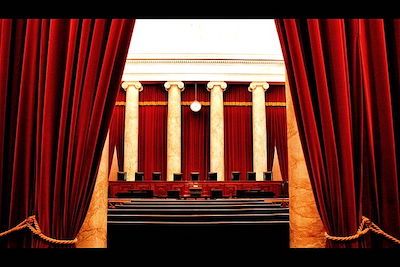“A retrospective change would mean a windfall for assignors and radically undercutting the return on the deal for a quarter century’s worth of assignees.” – Matthew Wolf, arguing for Hologic
 The U.S. Supreme Court heard oral arguments today in Minerva Surgical, Inc. v. Hologic, Inc., Cytyc Surgical Products, LLC, a case that essentially asks the Court to decide whether the doctrine of “assignor estoppel”—which bars the assignor of a patent from later attacking the patent’s validity—should be scrapped, retained or limited. The Court’s questioning indicated that it seems uncomfortable with discarding the doctrine entirely, as Minerva would like.
The U.S. Supreme Court heard oral arguments today in Minerva Surgical, Inc. v. Hologic, Inc., Cytyc Surgical Products, LLC, a case that essentially asks the Court to decide whether the doctrine of “assignor estoppel”—which bars the assignor of a patent from later attacking the patent’s validity—should be scrapped, retained or limited. The Court’s questioning indicated that it seems uncomfortable with discarding the doctrine entirely, as Minerva would like.
In January 2021, the Court granted a petition for certiorari filed by Minerva asking it to clarify the following question: “Whether a defendant in a patent infringement action who assigned the patent, or is in privity with an assignor of the patent, may have a defense of invalidity heard on the merits.”
Hologic, Inc. and Cytyc Surgical Products, respondents in the case, also filed a cross-petition for certiorari in November 2020. That petition asked the Court to address “whether an assignor of a patent may circumvent the doctrine of assignor estoppel by challenging the validity of the assigned patent in administrative proceedings before the Patent Office, and then using the Patent Office’s finding of invalidity to collaterally estop the assignee from relying on the patent in infringement litigation in district court.” It was denied in January.
The appeals relate to the U.S. Court of Appeals for the Federal Circuit (CAFC) ruling in April 2020 that assignor estoppel barred Minerva from asserting invalidity of its assigned patents in district court, after Hologic sued Minerva for infringement of those patents.
Today’s arguments featured Robert Hochman of Sidley Austin arguing for Minerva; Matthew Wolf of Arnold & Porter arguing for Hologic; and Morgan Ratner, Assistant to the Solicitor General, arguing for the U.S. Government.
Hochman: The Precedent is Not Well-Settled
Hochman was met with considerable resistance from the justices, who challenged Minerva’s argument that “assignor estoppel undermines, rather than serves, patent law values.” Minerva said in its petition that assignor estoppel is a judicially created and “textually groundless doctrine” that the CAFC has said does not apply at the Patent Trial and Appeal Board (PTAB) and thus puts the Federal Circuit “at odds with itself.”
In response to a question from Justice Thomas, Hochman said that the doctrines of issue preclusion and claim preclusion are distinguishable from assignor estoppel “both in the length of which they’ve been part of the common law and the uniformity with which they’ve been adopted—not just in patent cases, but…across the board.” Hochman added: “This Court for more than 150 years has said that those doctrines are implicit in the notion of a fair and efficient judicial system – assignor estoppel is nothing like that.”
Asked by Justice Breyer why the U.S. Government’s suggested limitations wouldn’t work, Hochman said that, although Minerva would win under the Government’s suggested middle-ground solution to “cabin the doctrine to its equitable core” by applying a “materially identical” test for claims subject to assignor estoppel, the test would introduce unnecessary ambiguity.
Justices Kagan and Kavanaugh asked Hochman what the “special justifications” were for overturning the Court’s precedent in Westinghouse Electric & Manufacturing Co. v. Formica Insulation Co., where the Court first endorsed the doctrine of assignor estoppel. Hochman said the precedent has not remained well-settled and has been undermined by cases like Lear, Inc. v. Adkins, which eliminated the doctrine of licensee estoppel.
In its petition, Minerva argued that the case for eliminating assignor estoppel is even stronger than the case that supported eliminating licensee estoppel, in fact, because—unlike licensee estoppel, which hurt the public and rewarded inventors, “assignor estoppel hurts the public by allowing bad patents to preclude public use of what should be in the public domain, and it disincentivizes further innovation in the field by exposing inventors’ new inventions to spurious claims of infringement of overbroad patent claims.”
Wolf: Only Congress Can Claw Back
When it was his turn, Wolf told the Court that it should be Congress handling the scales of justice in this case, not the Court. In Westinghouse, the Court held that assignor estoppel was manifestly intended by Congress, and in the 1988 ruling in Diamond Scientific v. Ambico, the Federal Circuit applied that case “without significant incident or controversy,” as “dozens” of other lower courts have. Congress also has maintained the relevant statutory language through multiple revisions of patent law, Wolf said. To overrule the doctrine would undermine “the hundreds of thousands of still extant bargains struck against the backdrop of assignor estoppel.”
The Chief Justice asked Wolf to address the Court’s statements in cases like Scott Paper v. Marcalus indicating that the assignor estoppel doctrine may not be all that strong, to which Wolf responded that the Court “expressly refused” to reverse Westinghouse in the Scott Paper case.
Justice Thomas asked Wolf how Congress can address assignor estoppel when it’s not currently in the Patent Act, but Wolf said that Westinghouse made clear that Section 261 of the Patent Act should be interpreted to embrace assignor estoppel and, whether one agrees with that interpretation or not, it should still be deferred to Congress.
Justice Sotomayor pushed back on Wolf for being resistant to any amount of limitation on the doctrine and asked why an assignor should be estopped if the claim they assign is ultimately broadened so much that it has no resemblance to the original? Wolf said that the assignor could go to the PTAB if she wanted, but with respect to making the argument in district court, since Section 112 invalidity is not distinguished from other kinds of validity, it would be barred by stare decisis.
Ultimately, said Wolf, the doctrine should be neither abrogated nor modified by the Court because assignees have historically relied on assignor estoppel and “a retrospective change would mean a windfall for assignors and radically undercutting the return on the deal for a quarter century’s worth of assignees.”
In his rebuttal, Hochman said that Hologic’s position essentially says that “whatever they can squeeze out of the patent, the assignor is stuck with. And that just doesn’t make any sense.” At the end of the day, “if you’re outside the scope of patent protection…the inventor, even an assignor, should be allowed to challenge it.”
The Middle-Ground
Ratner also argued for the U.S. government, and was asked by the justices to expand on the government’s proposed test for modifying the doctrine. The government in its brief said that “the Court should clarify [the doctrine’s] contours to ensure that assignor estoppel is not applied broadly and reflexively to circumstances where there is no logical inconsistency between an assignor’s prior representations and its current challenge to a patent’s validity.”
Likening it to the real property doctrine of estoppel by deed, the government said that there is no justification for abolishing the doctrine, but that they are “in favor of limiting the doctrine to its equitable core.” The brief explains:
Courts should therefore apply assignor estoppel only where the assignor sells patent rights for valuable consideration in an arm’s-length transaction, then either contests the validity of a claim materially identical to a claim issued or pending at the time of the assignment, or otherwise contradicts pre-assignment representations about the patent’s validity. As may be relevant here, assignor estoppel should not apply where the claim asserted to be invalid is broader than or otherwise different from the patent rights that were assigned.
Many commenters felt the Court was leaning toward adopting some version of the government’s test. Here are some quick takeaways on the arguments from today:
Teague Donahey , Holland & Hart
, Holland & Hart
“The justices raised a variety of different approaches and viewpoints during oral argument. But in the end, the overall tenor of the discussions seemed to suggest that Hologic’s stare decisis and judicial restraint arguments would carry the day and that assignor estoppel in some form would survive—perhaps with limiting principles along the lines of what the Solicitor General had proposed. In other words, the Court’s upcoming ruling is likely to provide a clarification, not a revolution.”
William H. Milliken , Sterne Kessler
, Sterne Kessler
“Based on the questions we heard at the Court today, most of the justices appear to be searching for a fair and workable way to constrain the doctrine of assignor estoppel—not a reason to overrule it completely. The Solicitor General’s proposed middle ground, in particular, received a great deal of attention during all three rounds of questioning. However, a few justices (Justice Thomas and Justice Gorsuch, in particular) expressed some discomfort with any form of assignor estoppel, given the Supreme Court’s prior criticisms of it, and its lack of textual footing in the 1952 Patent Act.”
Joe Re , Knobbe Martens
, Knobbe Martens
“The Supreme Court arguments reflected the justices’ keen knowledge about the reasons for preserving or discarding the doctrine of assignor estoppel. And repeatedly, the justices and the parties recognized how difficult it is to draw a line somewhere in the middle.
The argument also focused on whether the issue is best left for Congress to change the settled expectations of those who buy and sell patents, as Respondent urged. In other words, maybe the doctrine should be left alone in view of prior precedent, some of which is over 100 years old.
Many of the questions rightfully focused on the unique nature of patent rights, and how they differ from land sales and other physical personal property. Specifically, patent rights can change after an assignment, thus undercutting the warranty the assignor may have implied when assigning its patent or application. But the justices also fully understood the unfairness in the simple case when the assignor assigns an issued patent for valuable consideration. Respondent emphasized the money the assignor made from the sale of his patent rights, also knowing those patent rights could be amended in the future through prosecution.
But Justice Gorsuch correctly observed that anyone, including the assignor, may challenge the validity of any patent before the Patent Trial and Appeal Board. He thought it quite anomalous that the assignor estoppel doctrine seems to apply only in the courts.
In the end, the justices seem to recognize that the application of the doctrine requires looking at all of the relevant facts, such as what kind of representation did the assignor make when assigning the patent, to determine if the doctrine should apply.”
Irena Royzman, Ph.D. , Kramer Levin
, Kramer Levin
As Co-Chair of the New York Intellectual Property Law Association’s Amicus Committee she filed an amicus brief in the case.
“The justices described assignor estoppel as a ‘settled rule’ and indicated that it is one the Court is unlikely to abolish. The justices, however, appear to be considering a middle road approach advocated by the United States that would maintain equitable estoppel but limit its application. This approach applies assignor estoppel based on equity and the specific facts of each case, including an analysis of what was assigned and what patent claims are asserted against the assignor. It is consistent with the Supreme Court’s 1924 decision in Formica and would eliminate estoppel in cases where the asserted patent claims are divorced from what was invented or assigned.”

![[IPWatchdog Logo]](https://ipwatchdog.com/wp-content/themes/IPWatchdog%20-%202023/assets/images/temp/logo-small@2x.png)

![[[Advertisement]]](https://ipwatchdog.com/wp-content/uploads/2024/04/Patent-Litigation-2024-banner-938x313-1.jpeg)
![[Advertisement]](https://ipwatchdog.com/wp-content/uploads/2024/04/Artificial-Intelligence-2024-REPLAY-sidebar-700x500-corrected.jpg)
![[Advertisement]](https://ipwatchdog.com/wp-content/uploads/2024/04/UnitedLex-May-2-2024-sidebar-700x500-1.jpg)
![[Advertisement]](https://ipwatchdog.com/wp-content/uploads/2024/04/Patent-Litigation-Masters-2024-sidebar-700x500-1.jpg)

![[Advertisement]](https://ipwatchdog.com/wp-content/uploads/2021/12/WEBINAR-336-x-280-px.png)
![[Advertisement]](https://ipwatchdog.com/wp-content/uploads/2021/12/2021-Patent-Practice-on-Demand-recorded-Feb-2021-336-x-280.jpg)
![[Advertisement]](https://ipwatchdog.com/wp-content/uploads/2021/12/Ad-4-The-Invent-Patent-System™.png)






Join the Discussion
2 comments so far.
B
April 22, 2021 02:03 pm@ Pro Say “Gee; too bad the justices didn’t have that same lack-of-textual-footing concern with their extrajudicial, Senate-usurping, unconstitutional Mayo / Alice rewriting of Section 101.”
True. Since when has the SCOTUS ever cared about statutory language under Title 35?
Pro Say
April 21, 2021 07:04 pm“and its lack of textual footing in the 1952 Patent Act.”
Gee; too bad the justices didn’t have that same lack-of-textual-footing concern with their extrajudicial, Senate-usurping, unconstitutional Mayo / Alice rewriting of Section 101.
Hypocrisy, plain and simple.